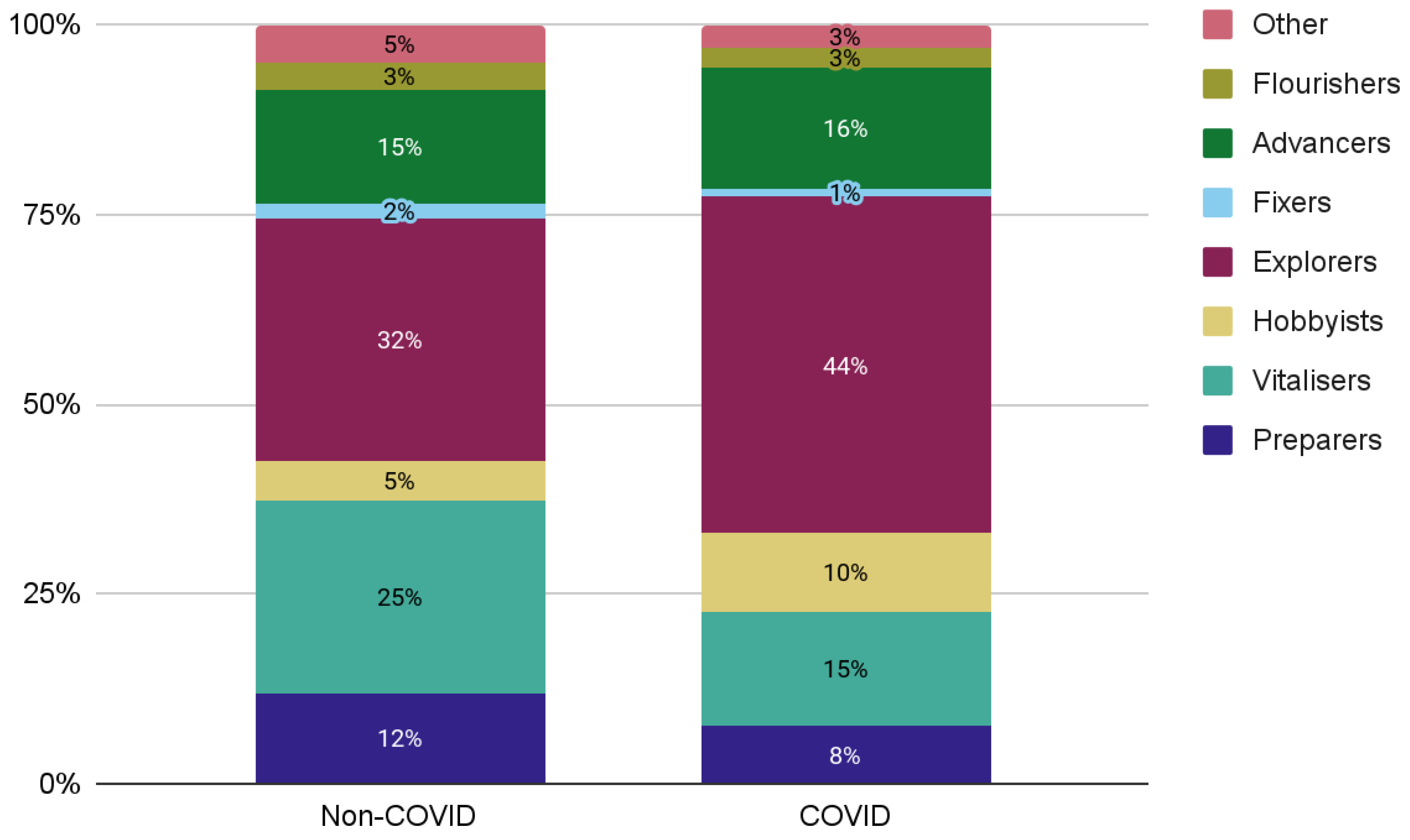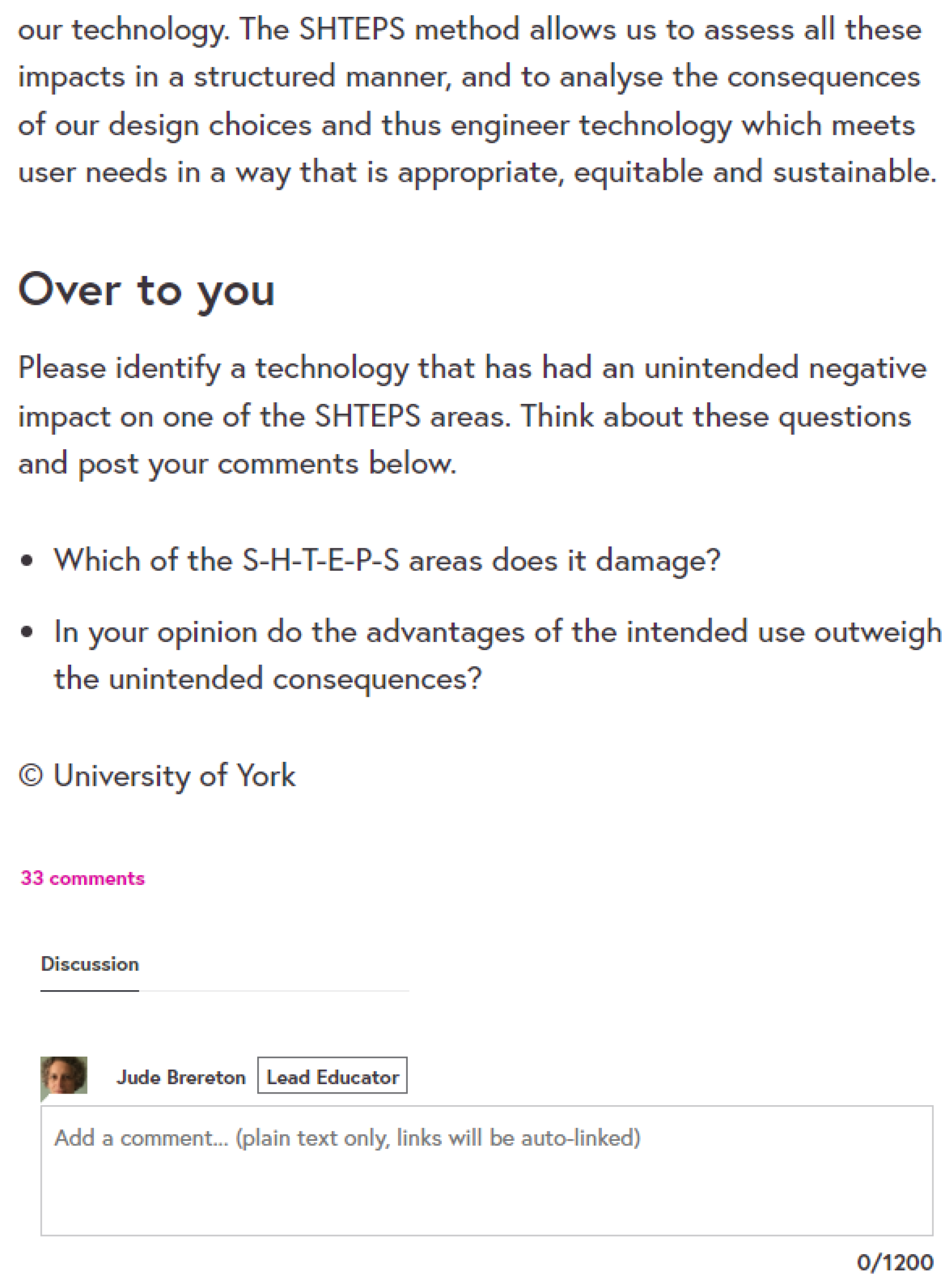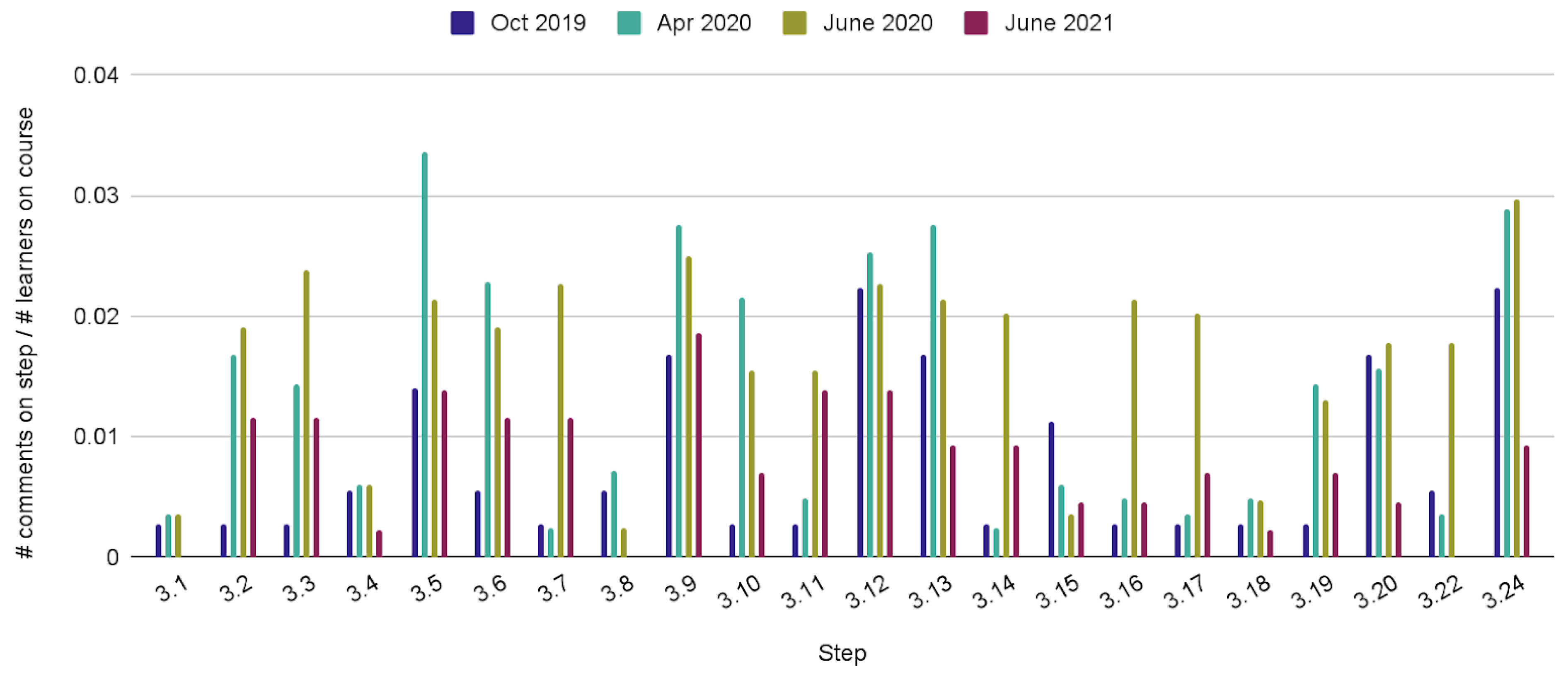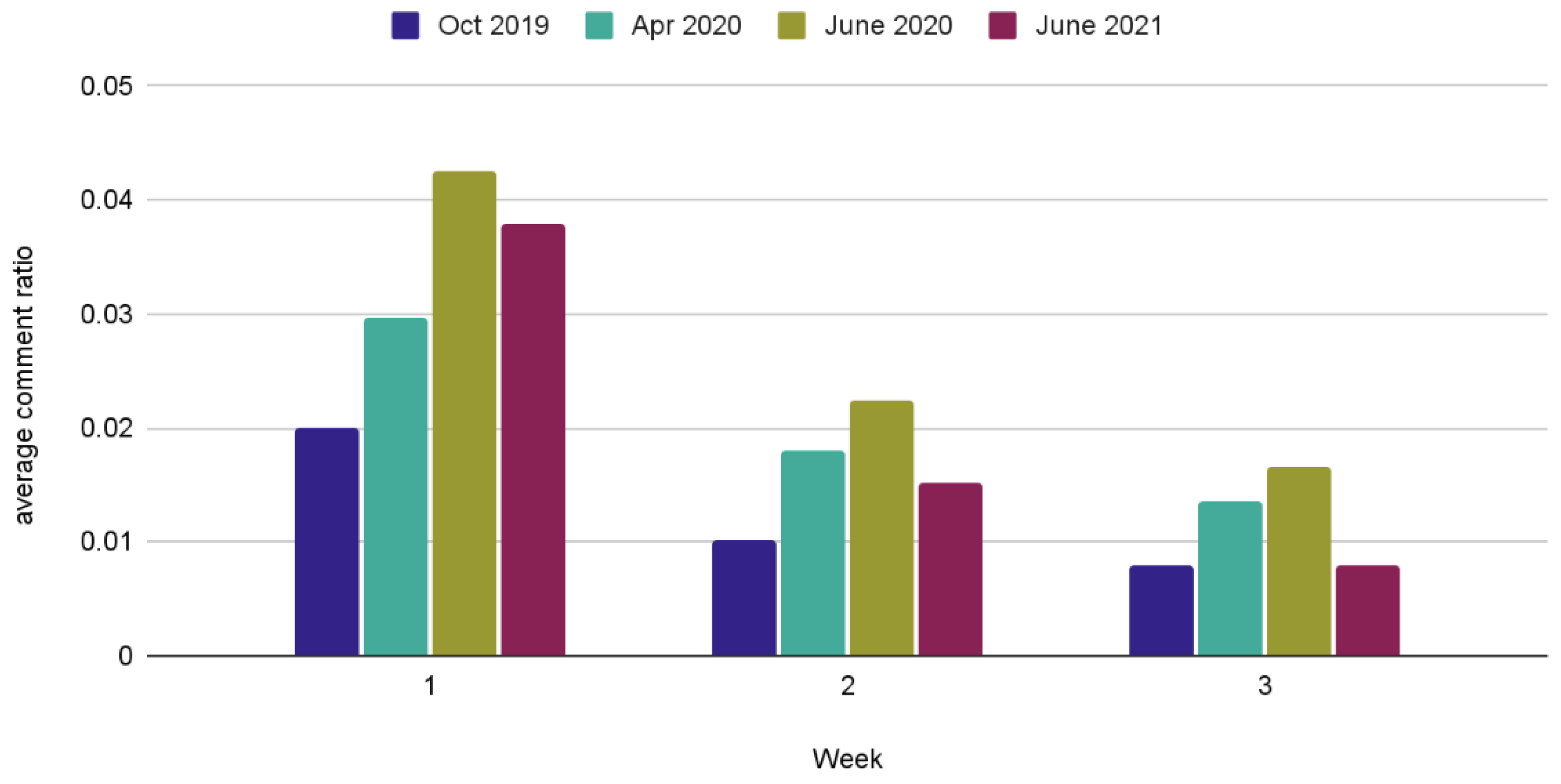Establishing Social Learning in an Engineering MOOC: Benefits for Diversity and Inclusion in Engineering Education
Abstract
1. Introduction
- the origins of engineering rooted in the history of the industrial revolution;
- a lack of diverse role models both in engineering education and industry;
- preconceptions of engineering as a discipline that requires physical strength; and
- a stereotypical image of engineering as a subject only for the “brainy”;
2. Materials
2.1. Engineering MOOC
- engage with school students and recent school leavers who might consider studying engineering at university;
- ensure participation from a wider diversity of learners than those typically found on engineering higher or further education study programmes in the UK; and
- counteract the stereotypical view of engineering as focussing on machines and technology rather than people, and that engineers are introverted and antisocial.
2.2. Data Sources
- Research Question A: Did the MOOC attract a diversity of learners?
- Research Question B: Did our learners engage in social collaborative learning?
- 7 October 2019
- 27 April 2020
- 29 June 2020
- 21 June 2021.
3. Research Question A: Diversity of Learners
3.1. Methods
- Advancers—already working, hoping to advance their career through learning;
- Explorers—may be looking for a career change, or making choices about their chosen career path;
- Preparers—starting their job, career, or study;
- Fixers—those undertaking learning to better understand an aspect of their personal life;
- Flourishers—using self-help to enhance their personal or professional life;
- Hobbyists—learning to support a current hobby or past-time;
- Vitalisers—learning as a hobby, lifelong learners learning for personal interest; and
- Other.
3.2. Results
3.2.1. Age
3.2.2. Gender
3.2.3. Learner Archetype
3.3. Discussion
4. Research Question B: Social Learning
4.1. Methods
4.1.1. Categories of Learners
- Joiner: Any person who has enrolled for the course-run;
- Learner: A user who has viewed one or more steps;
- Active Learner: A user who has completed (marked complete) one or more steps; and
- Social Learner: A user who has commented on one or more steps.
4.1.2. Number of Comments
- Number of comments overall;
- Number of comments for each week of the course;
- Number of comments for each learning step;
- Comments per step per Learner (referred to as “comment ratio”);
- Mean comment ratio for each week of the course;
- Mean comment ratio for each course run;
- Mean comments per step within one of three engineering application areas; and
- Number of comments with replies.
4.1.3. Changes to Comment Prompts
- Making it “obvious”;
- Using open-ended questions;
- Encouraging learners to use their imagination; and
- Using authentic or real-world tasks to put the discussion into a professional context.
4.2. Results: Categories of Learners
4.3. Results: Comments and Learning Steps
4.3.1. Comments Per Week and Per Step
4.3.2. Comments Per Step Per Learner (Comment Ratio)
4.3.3. Mean Comment Ratio within Engineering Application Area
4.3.4. Comments and Replies
4.4. Discussion
4.4.1. Overall Numbers of Comments
4.4.2. Commenting before and during COVID-19 Lockdown Restrictions
- 375% increase in total comments;
- 232% increase in learners;
- 389% increase in social learners;
- 63% increase in engaged social learners;
- 270% increase in average number of comments per step; and
- 61% increase in average comments per step per learner.
4.4.3. Commenting after the Restructure of Discussion Prompts
- 34% increase in total comments;
- 32% increase in average number of comments per step; and
- 33% increase in average comments per step per learner.
4.4.4. Commenting after Lockdown Restrictions Eased
4.4.5. Commenting According to Engineering Application Area
4.4.6. Commenting and Interacting
5. Limitations and Future Work
5.1. Age, Gender and Learner Type
5.2. Conversation Length and Commenter Interaction
5.3. Padlet Engagement
6. Conclusions
6.1. Recommendation 1: Carefully Structure Discussion Prompts
- Principle 1: Making it obvious/Signpost expected engagement
- Principle 2: Use open ended questions.
- Principle 3: Imaginative framing
- Principle 4: Professionalise the task/Using authentic scenarios.
6.2. Recommendation 2: Where Appropriate, Integrate Asynchronous Discussion in Blended Models
Author Contributions
Funding
Institutional Review Board Statement
Informed Consent Statement
Conflicts of Interest
References
- Armitage, L.; Bourne, M.; Jones, A.; Neave, S. Engineering UK 2020 Educational Pathways into Engineering; Engineering UK: London, UK, 2020; Available online: https://www.engineeringuk.com/media/232298/engineering-uk-report-2020.pdf (accessed on 29 September 2021).
- UNESCO. Cracking the Code: Girls’ and Women’s Education in Science, Technology, Engineering and Mathematics (STEM); UNESCO Publishing: Paris, France, 2017. [Google Scholar]
- The Institute of Engineering and Technology. Skills & Demand in Industry: 2017 IET Skills Survey; The Institute of Engineering and Technology: London, UK, 2017; Available online: https://www.theiet.org/media/8789/2017-skills-survey-issues-and-actions.pdf (accessed on 11 December 2017).
- Neave, S.; Wood, G.; May, T.; Tortis, M.; Kähärä, M.; Mellors-Bourne, R.; Morgan, R.; Desai, M.; Halej, J.; Talbot, M. Engineering UK 2018: The State of Engineering; Engineering UK: London, UK, 2018; Available online: https://www.engineeringuk.com/media/156187/state-of-engineering-report-2018.pdf (accessed on 29 September 2021).
- Du, X.; Kolmos, A. Increasing the diversity of engineering education—A gender analysis in a PBL context. Eur. J. Eng. Educ. 2009, 34, 425–437. [Google Scholar] [CrossRef]
- Faulkner, W. Genders in/of Engineering; The University of Edinburgh: Edinburgh, Scotland, 2006; Available online: http://www.amit-cat.org/doc/Faulkner_Genders_in_Engineering_Report.pdf (accessed on 2 September 2021).
- Marshall, H.; McClymont, L.; Joyce, L. Public Attitudes to and Perceptions of Engineering and Engineers 2007; The Royal Academy of Engineering & the Engineering and Technology Board: London, UK, 2007; Available online: https://www.raeng.org.uk/publications/other/public-attitude-perceptions-engineering-engineers (accessed on 29 September 2021).
- Direito, I.; Tilley, E.; Mitchell, J.E. Gender differences in first-year students’ expectations towards a new engineering multidisciplinary curriculum. In Proceedings of the 3rd International Conference of the Portuguese Society for Engineering Education (CISPEE), Aveiro, Portugal, 27–29 June 2018. [Google Scholar]
- Makarova, E.; Aeschlimann, B.; Herzog, W. The Gender Gap in STEM Fields: The Impact of the Gender Stereotype of Math and Science on Secondary Students’ Career Aspirations. Front. Educ. 2019, 4, 60. [Google Scholar] [CrossRef]
- Sochacka, N.W.; Walther, J.; Rich, J.R.; Brewer, M.A. A narrative analysis of stories told about engineering in the public discourse: Implications for equity and inclusion in engineering. Stud. Eng. Educ. 2021, 2, 54. [Google Scholar] [CrossRef]
- Whitehead, J.M. Sex stereotypes. gender identity and subject choice at A-level. Educ. Res. 1996, 38, 147–160. [Google Scholar] [CrossRef]
- Radford, J. Gender and Choice in Education and Occupation; Routledge: London, UK, 2002. [Google Scholar]
- Muller, C.B.; Ride, S.M.; Fouke, J.; Whitney, T.; Denton, D.D.; Cantor, N.; Nelson, D.J.; Plummer, J.; Busch-Vishniac, I.; Meyers, C.; et al. Gender differences and performance in science. Science 2005, 307, 1043. [Google Scholar] [CrossRef] [PubMed]
- Halpern, D.F.; Benbow, C.P.; Geary, D.C.; Gur, R.C.; Hyde, J.S.; Gernsbacher, M.A. The Science of Sex Differences in Science and Mathematics. Psychol. Sci. Public Interest A J. Am. Psychol. Soc. 2007, 8, 1–51. [Google Scholar] [CrossRef] [PubMed]
- Xie, Y.; Fang, M.; Shauman, K. STEM Education. Annu. Rev. Sociol. 2015, 41, 331–357. [Google Scholar] [CrossRef]
- Andrews, J.; Clark, R. Breaking down barriers: Teenage girls’ perceptions of engineering as a study and career choice. In Proceedings of the SEFI 40th Annual Conference, Thessaloniki, Greece, 23–26 September 2012; Société Eropéenne pour la Formation des Ingénieurs: Brussels, Belgium, 2012; pp. 274–275. [Google Scholar]
- Andrews, J.; Clark, R. “No one said girls could do engineering”: A fresh look at an old problem. In Proceedings of the International Conference on Innovation, Practice and Research in Engineering Education, Coventry, UK, 18–20 September 2012; Higher Education Academy: York, UK, 2012. Available online: https://research.aston.ac.uk/en/publications/no-one-said-girls-could-do-engineering-a-fresh-look-at-an-old-pro (accessed on 29 September 2021).
- Dasgupta, N.; Stout, J.G. Girls and Women in Science. Technology, Engineering, and Mathematics: STEMing the Tide and Broadening Participation in STEM Careers. Policy Insights Behav. Brain Sci. 2014, 1, 21–29. [Google Scholar] [CrossRef]
- Institute of Physics. What We’re Doing to Address Gender Imbalance in Physics, Institute of Physics; Institute of Physics: London, UK, 2021; Available online: https://www.iop.org/what-were-doing-address-gender-imbalance-physics (accessed on 26 March 2022).
- Busch-Vishniac, I.J.; Jarosz, J.P. Can Diversity in the Undergraduate Engineering Population BE Enhanced Through Curricular Change? J. Women Minorities Sci. Eng. 2004, 10, 255. [Google Scholar] [CrossRef]
- Holman, L.; Stuart-Fox, D.; Hauser, C.E. The gender gap in science: How long until women are equally represented? PLoS Biol. 2018, 16, e2004956. [Google Scholar] [CrossRef]
- Young, K.; Lovedee-Turner, M.J.; Brereton, J.S.; Daffern, H. The Impact of Gender on Conference Authorship in Audio Engineering: Analysis Using a New Data Collection Method. IEEE Trans. Educ. 2018, 61, 328–335. [Google Scholar] [CrossRef]
- National Academy of Engineering. Changing the Conversation: Messages for Improving Public Understanding of Engineering; The National Academies Press: Washington, DC, USA, 2008. [Google Scholar]
- Fidler, K. Engineering Engineering: A Provocation; Engineering Professors Council: Godalming, UK, 2021; Available online: http://epc.ac.uk/wp-content/uploads/2021/07/Eng-Eng-final.pdf (accessed on 8 March 2022).
- Centre for Engineering Education. Innovations in Engineering Education; UCL: London, UK, 2018; Available online: https://www.ucl.ac.uk/centre-for-engineering-education/sites/centre-for-engineering-education/files/ucl_cee_lrf_report_0.pdf (accessed on 27 August 2021).
- Lapadat, J.C. Written interaction: A key component in online learning. J. Comput.-Mediat. Commun. JCMC 2006, 7, JCMC742. [Google Scholar] [CrossRef]
- Ihsen, S.; Jeanrenaud, Y.; De Vries, P.; Hennis, T. Gender and Diversity in Engineering MOOCs, a first Appraisal. In Proceedings of the 43rd Annual Conference of the European Society for Engineering Education, Orléans, France, 26 June–2 July 2015; Société Eropéenne pour la Formation des Ingénieurs: Brussels, Belgium, 2015. [Google Scholar]
- Jiang, S.; Schenke, K.; Eccles, J.S.; Xu, D.; Warschauer, M. Cross-national comparison of gender differences in the enrollment in and completion of science, technology, engineering, and mathematics Massive Open Online Courses. PLoS ONE 2018, 13, e0202463. [Google Scholar] [CrossRef] [PubMed]
- Crues, R.W.; Henricks, G.M.; Perry, M.; Bhat, S.; Anderson, C.J.; Shaik, N.; Angrave, L. How do Gender. Learning Goals, and Forum Participation Predict Persistence in a Computer Science MOOC? ACM Trans. Comput. Educ. 2018, 18, 1–14. [Google Scholar] [CrossRef]
- Rovai, A.P. Building classroom community at a distance: A case study. Educ. Technol. Res. Dev. ETR D 2001, 49, 33. [Google Scholar] [CrossRef]
- Jivet, I.; Saunders-Smits, G. The effect of the covid-19 pandemic on a mooc in aerospace structures and materials. In Proceedings of the SEFI 2021 Annual Conference, Berlin, Germany, 13–16 September 2021; Société Eropéenne pour la Formation des Ingénieurs: Brussels, Belgium, 2021. Available online: https://www.researchgate.net/publication/354507918_THE_EFFECT_OF_THE_COVID-19_PANDEMIC_ON_A_MOOC_IN_AEROSPACE_STRUCTURES_AND_MATERIALS (accessed on 15 September 2021).
- Parsons, A. A Mooc with no Gobbledegook, Education in Chemistry; Royal Society of Chemistry: London, UK, 2017; Available online: https://edu.rsc.org/opinion/a-mooc-with-no-gobbledegook/3007729.article (accessed on 28 October 2018).
- Parsons, A.; Barr, I. MOOCs as “chemical attractants”. Waikato J. Educ. 2018, 23, 5–16. [Google Scholar] [CrossRef]
- Dewey, J. Experience and Education; Collier: New York, NY, USA, 1938. [Google Scholar]
- Margaryan, A.; Bianco, M.; Littlejohn, A. Instructional quality of Massive Open Online Courses (MOOCs). Comput. Educ. 2015, 80, 77–83. [Google Scholar] [CrossRef]
- Sharples, M. Social Learning and Large Scale Online Learning; FutureLearn: London, UK, 2013; Available online: https://www.futurelearn.com/info/blog/massive-scale-social-learning (accessed on 20 December 2021).
- Walker, T. Who Are Our Learners? Part 1: What We Did and Why; FutureLearn: London, UK, 2018; Available online: https://www.futurelearn.com/info/press/research-insights/learners-part-1 (accessed on 20 December 2021).
- Walker, T. Who Are Our Learners: Part 2: The ‘Work and Study’ Archetypes; FutureLearn: London, UK, 2018; Available online: https://www.futurelearn.com/info/press/research-insights/learners-part-2-work-study-archetypes (accessed on 31 January 2022).
- Parsons, A.F. Exploring Everyday Chemistry: The Effectiveness of an Organic Chemistry Massive Open Online Course as an Education and Outreach Tool. J. Chem. Educ. 2020, 97, 1266–1271. [Google Scholar] [CrossRef] [PubMed]
- Rayyan, S.; Seaton, D.T.; Belcher, J.; Pritchard, D.E.; Chuang, I. Participation and performance in 8.02x electricity and magnetism: The first physics MOOC from MITx. In Proceedings of the 2013 Physics Education Research Conference Proceedings, Portland, OR, USA, 17–18 July 2013; American Association of Physics Teachers: College Park, MD, USA, 2013. [Google Scholar] [CrossRef]
- Higher Education Statistics Agency. Higher Education Student Statistics: UK, 2020/21—Subjects Studied; Higher Education Statistics Agency (HESA): Cheltenham, UK, 2022; Available online: https://www.hesa.ac.uk/news/25-01-2022/sb262-higher-education-student-statistics/subjects (accessed on 5 February 2022).
- Lefever, S.; Dal, M.; Matthíasdóttir, Á. Online data collection in academic research: Advantages and limitations. Br. J. Educ. Technol. J. Counc. Educ. Technol. 2007, 38, 574–582. [Google Scholar] [CrossRef]
- Hutchison, J.; Tollefson, N.; Wigington, H. Response bias in college freshmen’s responses to mail surveys. Res. High. Educ. 1987, 26, 99–106. [Google Scholar] [CrossRef]
- Crawford, S.D.; Couper, M.P.; Lamias, M.J. Web Surveys: Perceptions of Burden. Soc. Sci. Comput. Rev. 2001, 19, 146–162. [Google Scholar] [CrossRef]
- Yetter, G.; Capaccioli, K. Differences in responses to Web and paper surveys among school professionals. Behav. Res. Methods 2010, 42, 266–272. [Google Scholar] [CrossRef]
- Jenner, M. Are Learners Learning? (and How Do We Know?); FutureLearn: London, UK, 2018; Available online: https://about.futurelearn.com/research-insights/learners-learning-know (accessed on 27 July 2021).
- Garrison, D.R.; Anderson, T.; Archer, W. Critical Inquiry in a Text-Based Environment: Computer Conferencing in Higher Education. Internet High. Educ. 2000, 2, 87–105. [Google Scholar] [CrossRef]
- Shea, P.; Li, C.S.; Swan, K.; Pickett, A. Developing learning community in online asynchronous college courses: The role of teaching presence. J. Asynchronous Learn. Netw. 2005, 9, 59–82. [Google Scholar] [CrossRef]
- Jacobi, L. The Structure of Discussions in an Online Communication Course: What Do Students Find Most Effective? J. Univ. Teach. Learn. Pract. 2017, 14, 11. [Google Scholar] [CrossRef]
- Morrison, B.B.; Quinn, B.A.; Bradley, S.; Buffardi, K.; Harrington, B.; Hu, H.H.; Kallia, M.; McNeill, F.; Ola, O.; Parker, M.; et al. Evidence for Teaching Practices that Broaden Participation for Women in Computing. In 2021 Working Group Reports on Innovation and Technology in Computer Science Education; Association for Computing Machinery (ITiCSE-WGR ’21): New York, NY, USA, 2022; pp. 57–131. [Google Scholar]
- Jordan, K. Initial trends in enrolment and completion of massive open online courses. Int. Rev. Res. Open Distrib. Learn. 2014, 15, 133–160. [Google Scholar] [CrossRef]
- Swinnerton, B.; Hotchkiss, S.; Morris, N.P. Comments in MOOCs: Who is doing the talking and does it help? J. Comput. Assist. Learn. 2017, 33, 51–64. [Google Scholar] [CrossRef]
- Lisitsa, E.; Benjamin, K.S.; Chun, S.K.; Skalisky, J.; Hammond, L.E.; Mezulis, A.H. Loneliness among young adults during COVID-19 pandemic: The mediational roles of social media use and social support seeking. J. Soc. Clin. Psychol. 2020, 39, 708–726. [Google Scholar] [CrossRef]
- Swan, K.; Garrison, D.R.; Richardson, J.C. A Constructivist Approach to Online Learning: The Community of Inquiry Framework. In Information Technology and Constructivism in Higher Education: Progressive Learning Frameworks; IGI Global: Hershey, PA, USA, 2009; pp. 43–57. [Google Scholar]
- Hicks, N.M.; Roy, D.; Shah, S.; Douglas, K.A.; Bermel, P.; Diefes-Dux, H.A.; Madhavan, K. Integrating Analytics and Surveys to Understand Fully Engaged Learners in a Highly-Technical STEM MOOC. In Proceedings of the 46th Annual Frontiers in Education Conference, FIE 2016, Erie, PA, USA, 12–15 October 2016; The Institute of Electrical and Electronics Engineers: New York, NY, USA, 2016. [Google Scholar]
- Aljohani, T.; Cristea, A.I. Learners Demographics Classification on MOOCs During the COVID-19: Author Profiling via Deep Learning Based on Semantic and Syntactic Representations. Front. Res. Metr. Anal. 2021, 6, 673928. [Google Scholar] [CrossRef]
- Tubman, P.; Oztok, M.; Benachour, P. Being Social or Social Learning: A Sociocultural Analysis of the FutureLearn MOOC Platform. In Proceedings of the 16th International Conference on Advanced Learning Technologies (ICALT), Austin, TX, USA, 25–28 July 2016; The Institute of Electrical and Electronics Engineers: New York, NY, USA, 2016; pp. 1–2. [Google Scholar]
- O’Riordan, T.; Millard, D.E.; Schulz, J. How should we measure online learning activity? Res. Learn. Technol. 2016, 24, 30088. [Google Scholar] [CrossRef][Green Version]
- Walton, G.M.; Logel, C.; Peach, J.M.; Spencer, S.J.; Zanna, M.P. Two brief interventions to mitigate a “chilly climate” transform women’s experience. relationships, and achievement in engineering. J. Educ. Psychol. 2015, 107, 468–485. [Google Scholar] [CrossRef]











| Age Range | Engineering MOOCs | FutureLearn Average | |
|---|---|---|---|
| # Learners | % Learners | ||
| <18 | 33 | 11% | 1% |
| 18–25 | 130 | 44% | 18% |
| 26–35 | 57 | 19% | 27% |
| 36–45 | 36 | 12% | 16% |
| 46–55 | 17 | 6% | 10% |
| 56–65 | 8 | 3% | 7% |
| >65 | 16 | 5% | 6% |
| Gender | Engineering MOOCs | |
|---|---|---|
| # Learners | % Learners | |
| Female | 117 | 38% |
| Male | 187 | 61% |
| Nonbinary | 3 | 1% |
| Learner Archetype | Engineering MOOCs | |
|---|---|---|
| # Learners | % Learners | |
| Preparers | 19 | 9% |
| Vitalisers | 39 | 18% |
| Hobbyists | 19 | 9% |
| Explorers | 89 | 41% |
| Fixers | 3 | 1% |
| Advancers | 34 | 16% |
| Flourishers | 6 | 3% |
| Other | 8 | 4% |
| Category | Definition | Presented Percentages |
|---|---|---|
| Joiner | Any person who has enrolled for the course run | n/a |
| Learners | Users who have viewed at least one step | Percentage of Joiners |
| Active Learners | Learners who have completed at least one step | Percentage of Learners |
| Social Learners | Learners who have posted at least one comment on any step | Percentage of Learners |
| Introducers | Learners who made comments only in the introductory steps (1–3) | Percentage of Learners |
| Engaged Social Learners | Learners who made comments on or after the fourth learning step | Percentage of Learners |
| Step | Step Title | # Comments April 2020 | Commenting Prompt Amendment | # Comments June 2020 |
|---|---|---|---|---|
| 1.7 | Sensors used in medicine now | 0 | Added comment prompt heading “What about you?” | 68 |
| 1.4 | Welcome to Week 1: engineering for health | 18 | Rewrote last paragraph: “Have your say Put a comment here if you use some form of technology to track your health (smartwatch, fitbit, clever shoes!). Tell us what it is, what you use it for, and how it has helped you.” | 122 |
| 2.3 | Health and water quality | 11 | No comment prompt in April 2020—we added: “Exercise: How would you summarise the above article in less than 100 words? Engineers are often asked to read and understand complex situations and technologies, then explain them briefly to different people. Have a go at writing a summary, and post your replies below.” | 49 |
| 1.11 | Healthcare: from sensors to signals | 6 | We added: “A Thought Experiment for You Imagine you met a friendly alien from outer space, who understood written English (as they do in many science fiction films). They point to your ears and type “What are those for?” You notice they have no ears and probably are not aware of sound. How would you describe what sound is to a being from a place where sound is not heard?” | 62 |
| October 2019 | April 2020 | June 2020 | June 2021 | |
|---|---|---|---|---|
| Joiners | 554 | 1144 | 1569 | 726 |
| Learners | 358 | 833 | 840 | 432 |
| # Comments: Week 1 | # Comments: Week 2 | # Comments: Week 3 | # Learners | # Social Learners | |
|---|---|---|---|---|---|
| October 2019 | 150 | 84 | 62 | 358 | 65 |
| April 2020 | 519 | 344 | 248 | 833 | 253 |
| June 2020 | 752 | 432 | 308 | 840 | 284 |
| June 2021 | 344 | 150 | 75 | 432 | 118 |
| Average Comments Per Step | % Change from Previous Run | |
|---|---|---|
| October 2019 | 4.63 | - |
| April 2020 | 17.09 | 270% |
| June 2020 | 22.61 | 32% |
| June 2021 | 9.03 | −60% |
| Mean Comment Ratio | % Change from Previous Run | Number of Learners “Required” for 1 Comment | |
|---|---|---|---|
| October 2019 | 0.0125 | - | 79.82 |
| April 2020 | 0.0202 | 61% | 49.49 |
| June 2020 | 0.0269 | 33% | 37.16 |
| June 2021 | 0.0200 | −26% | 50.11 |
| Topic | October 2019 | April 2020 | June 2020 | June 2020 | Average of the 4 Course Runs |
|---|---|---|---|---|---|
| Medical | 0.0133 | 0.0230 | 0.0301 | 0.0261 | 0.0231 |
| Sound | 0.0156 | 0.0247 | 0.0302 | 0.0215 | 0.0230 |
| Robotics | 0.0056 | 0.0103 | 0.0164 | 0.0091 | 0.0103 |
| Replies | % of Comments on Course-Run | |
|---|---|---|
| October 2019 | 27 | 7.28% |
| April 2020 | 102 | 7.26% |
| June 2020 | 108 | 5.84% |
| June 2021 | 45 | 6.47% |
| Learning Step | Description of Learning Activity or Task |
|---|---|
| 3.1 | No task prompt section Welcome video |
| 2.8 | No task prompt section Introduction to set of steps |
| 1.19 | No task prompt section Information giving (via text or video) |
| 1.17 | |
| 2.21 | |
| 3.18 | |
| 1.22 | Task prompt section present Activity is a thought experiment and asks for thoughts |
| 2.13 | Task prompt section present Activity requires trying out an activity using a mobile app, posting the results to a Padlet, then commenting |
| 3.8 | |
| 1.20 | Task prompt section present Activity requires doing an experiment and coming back to report on results |
| Learning Step | Description of Learning Activity or Task |
|---|---|
| 2.09 | No specific task prompt, but requests learner to think and give examples |
| 2.02 | Task prompt: post short answer in comment, post image on Padlet |
| 2.10 | |
| 1.06 | Task prompt: think and give examples |
| 3.09 | |
| 3.24 | |
| 1.08 | |
| 1.12 | |
| 3.05 | |
| 3.12 | Task prompt: respond to audio clips with thoughts |
Publisher’s Note: MDPI stays neutral with regard to jurisdictional claims in published maps and institutional affiliations. |
© 2022 by the authors. Licensee MDPI, Basel, Switzerland. This article is an open access article distributed under the terms and conditions of the Creative Commons Attribution (CC BY) license (https://creativecommons.org/licenses/by/4.0/).
Share and Cite
Brereton, J.S.; Young, K. Establishing Social Learning in an Engineering MOOC: Benefits for Diversity and Inclusion in Engineering Education. Sustainability 2022, 14, 5472. https://doi.org/10.3390/su14095472
Brereton JS, Young K. Establishing Social Learning in an Engineering MOOC: Benefits for Diversity and Inclusion in Engineering Education. Sustainability. 2022; 14(9):5472. https://doi.org/10.3390/su14095472
Chicago/Turabian StyleBrereton, Jude S., and Kat Young. 2022. "Establishing Social Learning in an Engineering MOOC: Benefits for Diversity and Inclusion in Engineering Education" Sustainability 14, no. 9: 5472. https://doi.org/10.3390/su14095472
APA StyleBrereton, J. S., & Young, K. (2022). Establishing Social Learning in an Engineering MOOC: Benefits for Diversity and Inclusion in Engineering Education. Sustainability, 14(9), 5472. https://doi.org/10.3390/su14095472






